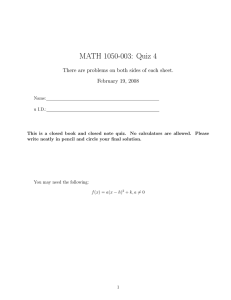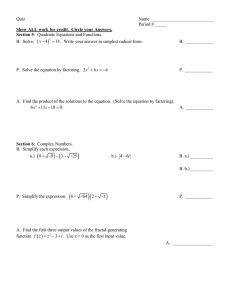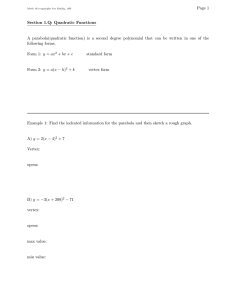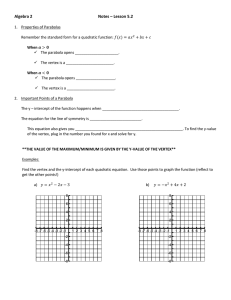Poly 1.2 Completing the Square
advertisement
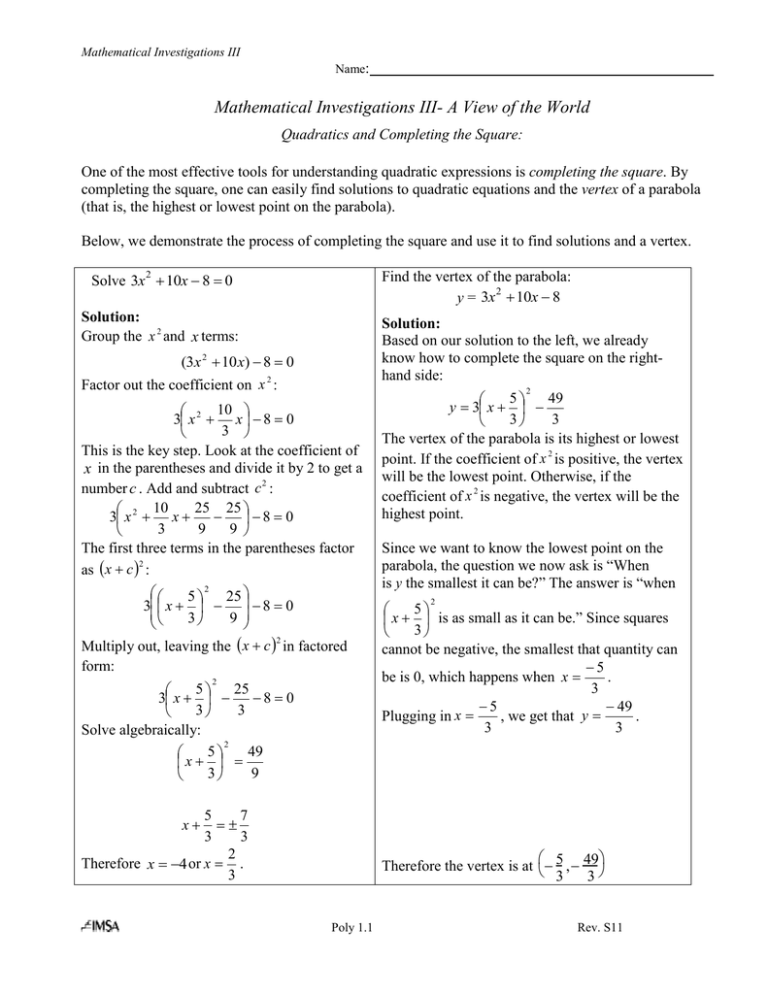
Mathematical Investigations III Name: Mathematical Investigations III- A View of the World Quadratics and Completing the Square: One of the most effective tools for understanding quadratic expressions is completing the square. By completing the square, one can easily find solutions to quadratic equations and the vertex of a parabola (that is, the highest or lowest point on the parabola). Below, we demonstrate the process of completing the square and use it to find solutions and a vertex. Solve 3x 2 10x 8 0 Find the vertex of the parabola: 2 y = 3x 10x 8 Solution: Group the x 2 and x terms: Solution: Based on our solution to the left, we already know how to complete the square on the righthand side: (3x 2 10 x) 8 0 Factor out the coefficient on x 2 : 2 10 3 x 2 x 8 0 3 This is the key step. Look at the coefficient of x in the parentheses and divide it by 2 to get a number c . Add and subtract c 2 : 10 25 25 3 x 2 x 8 0 3 9 9 The first three terms in the parentheses factor 2 as x c : 2 5 25 3 x 8 0 3 9 2 Multiply out, leaving the x c in factored form: 2 5 25 3 x 8 0 3 3 Solve algebraically: 2 5 49 x 3 9 5 7 3 3 2 Therefore x 4 or x . 3 5 49 y 3 x 3 3 The vertex of the parabola is its highest or lowest point. If the coefficient of x 2 is positive, the vertex will be the lowest point. Otherwise, if the coefficient of x 2 is negative, the vertex will be the highest point. Since we want to know the lowest point on the parabola, the question we now ask is “When is y the smallest it can be?” The answer is “when 2 5 x is as small as it can be.” Since squares 3 cannot be negative, the smallest that quantity can 5 be is 0, which happens when x . 3 5 49 Plugging in x , we get that y . 3 3 x 5 49 Therefore the vertex is at 3 , 3 Poly 1.1 Rev. S11 Mathematical Investigations III Name: For each of the following: a. Solve f ( x) 0 by completing the square. b. Find the vertex of the parabola y f (x) by completing the square. c. Sketch a quick graph of y f (x) , labeling the vertex and zeroes. 1. f ( x) x 2 8 x 48 a. b. c. 2. f ( x) 4 x 2 8 x 5 a. b. c. 3. f ( x) 2 x 2 10 x 9 a. b. c. Poly 1.2 Rev. S11 Mathematical Investigations III Name: 4. f ( x) x 2 6 x 13 a. General formulas: b. c. The Quadratic Formula and the Vertex of a Parabola. Now that you are familiar with completing the square in specific examples, try it in a more general setting to derive the quadratic formula and a formula for the vertex of a parabola. 5. Given the quadratic function f ( x) ax 2 bx c : a. Complete the square on the expression on the right-hand side. b. Use your answer to Part (a) to solve f ( x) 0 . c. Use your answer to Part (a) to find the vertex of the parabola y f (x) . a. b. c. Poly 1.3 Rev. S11 Mathematical Investigations III Name: In Question 5, you should have observed the following: For a quadratic function f ( x) ax 2 bx c : (1) (The Quadratic Formula) The solutions to f ( x) 0 are x b b 2 4ac . 2a b b 2 4ac . (2) The vertex of the parabola y f (x) is at the point , 4a 2a Extra Observation: Notice the relationship between the two results above. Look at the graph of the parabola at the left, with vertex C and zeros at A and B. C A B D 2 y 1 x 5 9 x Find the coordinates of C, A, B, and D: Find the distances AD and DB. What is the relationship of these to the quadratic formula values for A and B ? 2 b b 4ac 2a 2a Poly 1.4 Rev. S11


